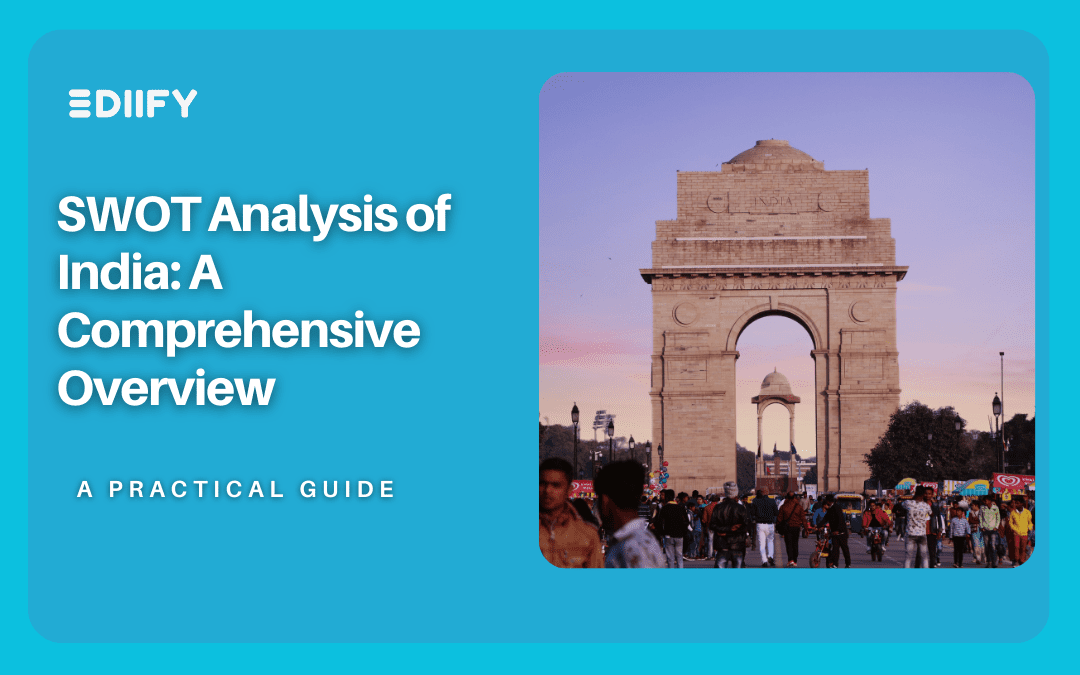Introduction:
India, a nation celebrated for its diversity, rich cultural tapestry, and dynamic economy, holds a significant position on the global stage. Boasting a population exceeding 1.3 billion and a rapidly expanding economy, India’s trajectory is one of continual evolution. To grasp its current standing and potential future, a SWOT analysis offers invaluable insights. This analytical framework helps in discerning India’s strengths, weaknesses, opportunities, and threats, providing a nuanced understanding of its present challenges and future prospects.

Strengths:
India possesses numerous strengths that form the bedrock of its economic and social fabric. Foremost among these is its demographic dividend, characterized by a youthful population that propels labor force participation and consumption. Additionally, India’s thriving IT sector, renowned for its software services and innovation, has positioned the nation as a global technology leader, fostering entrepreneurship and attracting substantial foreign investment.
Moreover, India’s rich cultural heritage and diverse tourism offerings significantly bolster its soft power and global appeal. The country’s democratic governance structure and vibrant civil society enhance stability, fostering an environment conducive to creativity and innovation. Lastly, India’s expansive agricultural sector, coupled with ongoing reforms, holds immense potential for sustainable growth and ensuring food security.
Take a look at the below blog Achieving an Inclusive Classroom Strategy
https://ediify.com/achieving-an-inclusive-classroom-strategy/
Weaknesses:
Despite its strengths, India contends with several weaknesses that impede its progress. Infrastructure deficiencies, including inadequate transportation networks and power supply, hamper economic development and productivity. Additionally, bureaucratic red tape and regulatory complexities often stifle business growth and deter foreign investment.
India’s education system, while vast, grapples with challenges of quality and accessibility, hindering human capital development and innovation. Social inequalities, including gender disparities and caste divisions, persist as significant challenges, inhibiting inclusive growth and social cohesion. Furthermore, environmental degradation and resource scarcity pose existential threats, necessitating urgent adoption of sustainable development strategies.
Opportunities:
India’s vast potential is underscored by numerous opportunities for growth and development. The rapid pace of urbanization presents fertile ground for infrastructure investment, smart city initiatives, and sustainable urban planning. Additionally, the digital revolution offers avenues for leapfrogging traditional barriers, fostering inclusive growth, and expanding access to essential services like education, healthcare, and finance.
The burgeoning middle class and rising consumer demand in India fuel opportunities across various sectors, including retail, healthcare, and entertainment. Initiatives in renewable energy, driven by concerns about climate change and technological advancements, pave the way for clean energy adoption and environmental stewardship. Strategic partnerships and global collaborations offer avenues for knowledge exchange, innovation, and economic cooperation, further enhancing India’s prospects on the world stage.
Threats:
Despite its promise, India faces several threats that could potentially derail its growth trajectory. Geopolitical tensions, regional conflicts, and border disputes pose risks to stability and investor confidence, potentially undermining economic progress. Economic volatility, exacerbated by external shocks and domestic policy uncertainties, threatens to disrupt growth momentum and exacerbate poverty and inequality.
Moreover, social unrest, fueled by identity politics, religious tensions, and socioeconomic disparities, poses a significant risk to social cohesion and democratic values. Environmental degradation, exacerbated by the impacts of climate change and unsustainable development practices, poses severe threats to public health, food security, and ecological balance, necessitating immediate action.
Take a view at the below blog Exploring the benefits of the Flipkart business model
https://ediify.com/exploring-the-benefits-of-the-flipkart-business-model/
Conclusion:
India’s journey towards prosperity and development is marked by a complex interplay of strengths, weaknesses, opportunities, and threats. While the nation possesses immense potential driven by its demographic dividend, technological prowess, and cultural richness, it must address challenges such as infrastructure deficits, social inequalities, and environmental degradation to realize its full potential.
Effectively navigating these complexities demands visionary leadership, inclusive policymaking, and concerted efforts across sectors. Embracing opportunities such as digital transformation, sustainable development, and global partnerships can unlock India’s true potential and propel it towards a brighter future. By addressing weaknesses and mitigating threats, India can harness its strengths to emerge as a global powerhouse, driving inclusive growth, innovation, and prosperity for its citizens and the world at large.

For more information visit the mentioned website


